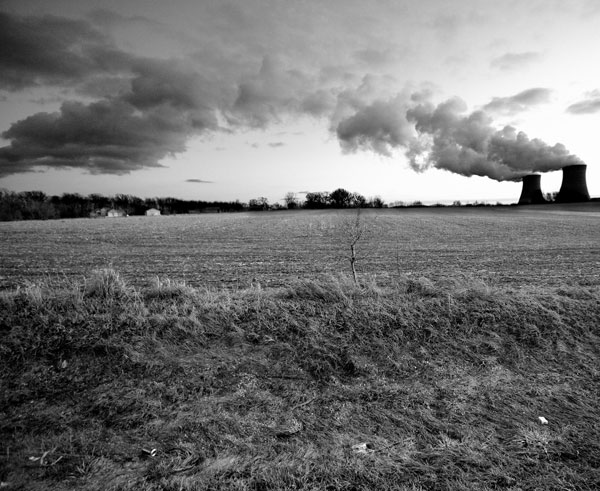
As the situation at the damaged Fukushima Nuclear Power Plant continues to be touch-and-go, locals are starting to worry about the state’s nuclear power plants, which are many–half the state’s power comes from nuclear energy. WBEZ talked to Stephen Schwartz of The Nonproliferation Review, who pointed out that the similarly designed Dresden 2 and 3 plants are less than an hour from Chicago; in another interview, Rick Zuffa of the Illinois Emergency Management Agency discussed the state’s nuclear emergency plans.
So could the Midwest be at risk for a nuclear meltdown? Actually, we’ve already had one, but I’ll get to that in a minute.
There’s no yes or no answer when it comes to risk assessment, but the probability of a disaster caused by an earthquake is very low. The Fukushima plant was designed to withstand a peak ground acceleration (explanation here; it’s more useful than magnitude since it measures actual ground movement) of .18 g, according to National Geographic. The peak acceleration at the earthquake’s epicenter, meanwhile, was .35 g, though it’s currently unclear what the peak ground acceleration was at the plant, or how much of the damage was caused by the earthquake itself, as opposed to the tsunami.
In Chicago, the biggest risk for an earthquake would be from the New Madrid Seismic Zone (it’s the New Madrid earthquake bicentennial, by the way, you can listen to Uncle Tupelo to celebrate). But that’s a long way away. The clearest prediction I could find for the possible effects of a major New Madrid earthquake comes from an IDOT/IIT study (PDF), which said:
considering a 50-year return period for a major earthquake in NMSZ, the level of acceleration experienced in Northern Illinois will be about 0.02g. This will cause slight damage to about 1% of URM buildings. For 200-year and 500-year return periods, the accelerations will be 0.06g and 0.07g, respectively. The corresponding slight damage effects will be to about 18% and 23% of URM [unreinforced masonry] buildings.
In short, the damage to basic life and limb would likely overshadow the risk to nuclear reactors, and St. Louis and Memphis have much more reason to worry.
Of more concern to us: twisters. The Straight Dope’s Cecil Adams has a good explanation of the risks nuclear reactors face from tornadoes. Note the last paragraph:
The Nuclear Regulatory Commission seems anxious to demonstrate that it’s not taking a casual attitude toward these things. In 2009 it rejected the Westinghouse AP-1000 reactor design — regulators feared the shield building, with walls of steel and concrete three feet thick, might not be strong enough.
Here’s more about the AP-1000 rejection. It was revised and is nearing approval from the Nuclear Regulatory Commission, but the NRC engineer largely responsible for the first rejection remains unsatisfied. Another recently voiced criticism comes from Edwin Lyman of the Union of Concerned Scientists, who’s concerned about standards for backup systems, since it was a backup failure that precipitated the Fukushima crisis. The Sun-Times‘s David Roeder has more on backup systems and blackouts.
Also a concern: power sources that aren’t nuclear. Nuclear crises generate a lot of fear because of the mysterious, primordial forces involved and the possibility of enormous catastrophe, but that’s not to say that other sources of power are safe, as William Saletan points out. Comparatively speaking, coal-fired power plants (the other half of Illinois’ power besides nuclear, generally speaking) are the water slowly boiling the frog to death, or at least giving it chronic asthma.
But perhaps the biggest worry when it comes to nuclear power should be, um, people. Right now it appears the Fukushima plant has suffered a partial meltdown–which we’ve already had once in a Great Lakes power plant, and it didn’t take an act of God for it to happen:
The 1966 accident that crippled the Enrico Fermi-1 fast breeder in Detroit was caused by a safety device added belatedly at the insistence of the Advisory Committee on Reactor Safeguards. The device came loose inside the core and blocked the coolant, causing a meltdown of two fuel elements.
Sure, it’s not as famous as Three Mile Island, but Gil-Scott Heron did write a song about it.
And that Dresden site so close to the city? It caused a 1970 scare:
It started with a minor malfunction that led to a chain of events–complex but not improbable–that caused damage in the core but stopped short of a disaster. Key equipment did not function adequately, the reactor operator did the wrong thing, there was a glaring error of design in the positioning of a safety valve–but there was no release of radioactivity outside the plant.
Photograph: Bistrosavage (CC by 2.0)



